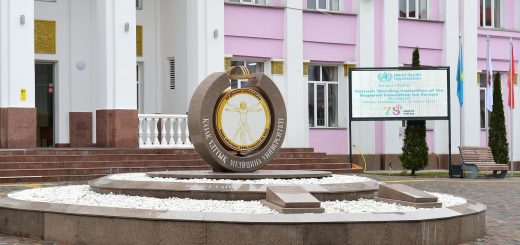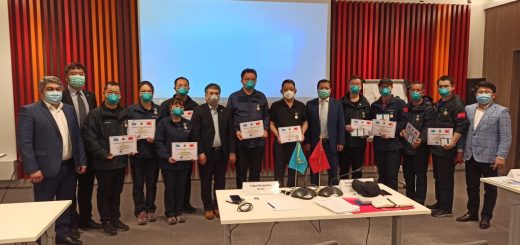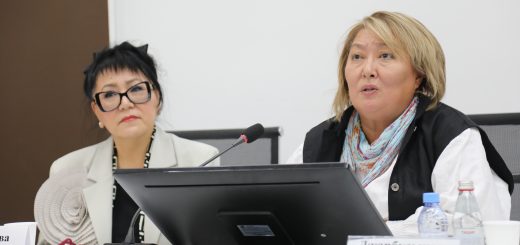Scientists from Kazakhstan Train at the Buck Institute Focused on a Project to Improve Diabetes Care at Home
CONTACT: Kris Rebillot
Director of Communications
Buck Institute for Research on Aging
(415) 209-2080
March 20, Novato, CA: Five scientists from Kazakhstan are being trained on cutting-edge stem cell and genomic technology at the Buck Institute, in a Kazakhstan Ministry of Health-funded project aimed at designing novel therapeutics to treat skin wounds caused by diabetes. The training will enable the scientists to work in a new Genomic Facility being established at Asfendiyarov Kazakh National Medical University (KazNMU), which is sponsoring their activities at the Buck along with the Ministry of Education and Science and the JSC “Center for International Programs” (Republic of Kazakhstan).
Like much of the world, diabetes is reaching epidemic proportions in Kazakhstan, a large country in central Asia. The project deployed at Buck builds on a clinical trial at KazNMU where patients with diabetic wounds under the treatment with interleukin 2 (IL-2) have achieved significant improvement over traditional diabetic ulcer care which includes extracellular matrix replacement therapy, negative pressure wound therapy or treatments with growth factors and bio-engineered tissue and skin substitutes. None of the traditional therapies is completely perfect and each suffers from its own disadvantages.
Interleukin-2 was discovered more than 20 years ago and is classified as a “biological response modifier” – it helps increase production of several different components of the immune system found in the blood, including T lymphocytes and natural killer cells. Buck Associate Professor, Victoria Lunyak, PhD, whose lab is a recipient of the KazNMU project, is mentoring the visiting scientists. She says while the clinical trial was generally successful in treating diabetic wounds, scientists want to do better.
“No one knows how IL-2 treatment works in regards to healing diabetic ulcers. In the context of the funded project, my lab is focusing on how IL-2 influences adult human mesenchymal stem cells (MSCs).” Lunyak says MSCs possess the ability to impart profound effects on the immune system. “Whereas the exact mechanisms underlying the immune regulating functions of MSCs remain largely unknown, these cells have been exploited in a variety of clinical trials aimed at reducing the burden of immune-mediated disease. In our joint venture with KazNMU, we want to understand the pathways involved in the immunomodulatory properties of MSC with an eye towards providing novel insight into the drug’s potential to enhance cell-based therapy for immune-mediated disorders and, in particular, diabetes,” she said.
The Kazakh scientists want to discover how the transcriptional make up, or “transcriptome” of stem cells from different patients both young and of advanced age change when treated with differing doses of IL-2. A transcriptome is a collection of all the transcripts, or instructions, that come into play when DNA is transcribed into corresponding molecules of ribonucleic acid (RNA) within the cell.
Lunyak says the Kazakh scientists have an advantage over most researchers working in this country – they are being trained to use Ion Torrent™ technology, a next-generation sequencing platform named the Ion Proton™ system that uses semiconductor chips similar to those used in the electronics industry. Ion Torrent™ semiconductor sequencing technology achieves 99.6 % raw accuracy in reading genomic information with the cost per run significantly lower than that of alternative sequencing methods. “We can run a sample and get a sequence in two hours instead of the several days required with standard, existing equipment,” said Lunyak. “This is the sequencing technology of the future. With its affordable high throughput format, this technology will help to enable personalized medicine in the future. Our scientists-in-training plan to take advantage of it.”
Just as important as learning how to use the new technology, the Kazakh scientists are also being trained to design and run genomic experiments. Sain Bakhretdinov, a practicing endocrinologist at KazNMU, welcomes the opportunity to be at the Buck Institute. “I am learning how to think like a researcher,” he said. “I can be of more benefit to my patients by learning how to develop new treatments for disease and future ’personalized diagnostics‘ approaches – this is where I want to put my attention.”
The visiting Kazakh scientists are at the Buck Institute for periods ranging from three to 12 months, in a program that could eventually expand. “This program is expected to be a great success as it has already proved there are very good and fruitful results ahead,” said Aikan Akanov, Rector at KazNMU. “With the financial assistance we receive from the JSC ’Center for International Programs’ and with the University’s own funding we are able to have this part of our research done with our US partners. It is our biggest hope that this research would enable our younger scientists to make significant contributions to medicine.”
The Ion Proton™ Sequencer is for Research Use Only, not for use in diagnostic procedures.
About the Buck Institute for Research on Aging
The Buck Institute is the U.S.’s first independent research organization devoted to Geroscience – focused on the connection between normal aging and chronic disease. Based in Novato, CA, The Buck is dedicated to extending “Healthspan”, the healthy years of human life and does so utilizing a unique interdisciplinary approach involving laboratories studying the mechanisms of aging and those focused on specific diseases. Buck scientists strive to discover new ways of detecting, preventing and treating age-related diseases such as Alzheimer’s and Parkinson’s, cancer, cardiovascular disease, macular degeneration, osteoporosis, diabetes and stroke. In their collaborative research, they are supported by the most recent developments in genomics, proteomics, bioinformatics and stem cell technologies. For more information: www.thebuck.org.
About Asfendiyarov Kazakh National Medical University (KazNMU)
Asfendiyarov Kazakh National Medical University was established in 1930 and has successfully celebrated its 83rd year in the national educational system of Kazakhstan. Today, the University educates approximately 12 thousand students in all levels of medical and paramedical education including Master’s and PhD levels. The University is committed to motivating young minds to be involved in science and research, through the Atchabarov Scientific-Research Institute of Fundamental and Applied Medicine, which is very well equipped and based on the knowledge that science is the foundation for everything surrounding us: http://www.kaznmu.kz/





